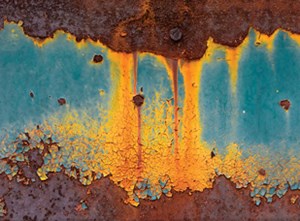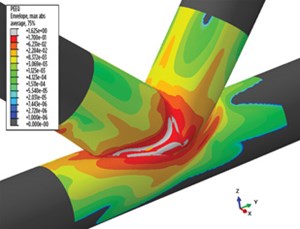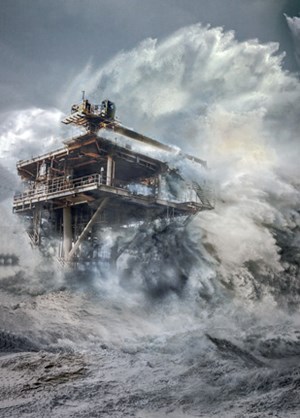Structural integrity management in late asset life: Sustainable operations maximize returns
From the North Sea and offshore Brazil to the northern Caspian Sea and the Gulf of Mexico, offshore oil and gas assets are designed to cope with all extremes, while catering to an ever-increasing operating weight.
What’s more, over a third of offshore platforms, worldwide, are operating beyond their original design life. This means that late life management is gaining importance, particularly as operators seek to improve value in this lower-price environment.
When considering aging and life extension of installations, it’s essential for operators to have a thorough understanding of their assets. A first-rate structural integrity management system (SIMS) helps to enhance asset value by ascertaining capacity to support modifications or developments, and identifies scope to mitigate costly interventions.
With specialist knowledge and global experience, Wood has a proven ability to manage structural integrity throughout an asset’s lifecycle.
This article outlines the company’s proven structural integrity approach and considers the pivotal role of SIMS in late life asset management. Ultimately, it will detail how specialist services enable customers to realize safe, reliable production in later life, using SIMS.
SETTING THE SCENE
As assets age, there is a trend toward decreasing revenues and increasing costs. Life extension and the implementation of an effective SIMS can help address these trends and increase an asset’s return on investment.
Additional motivation for life extension could be:
- Discovery of additional reserves
- Accommodating tie-backs
- Enhancing oil recovery
- Deferring decommissioning costs.
Assets face several aging mechanisms that pose a risk to structural integrity during life extension, including:
- Corrosion: the impact of the harsh environment, Fig. 1.
- Overload: any increase or redistribution in topside weight, or resist increased environmental loads associated with improved metocean predictions
- Fatigue: environmental conditions can push the structure beyond the original design assessments in late life
- Incidents: although not technically an aging mechanism, the risk of ship collision, fire or explosion, must be re-assessed, due to operational or logistical changes.

FLOATING STRUCTURES
The issue extends beyond fixed structures. In fact, some floating installations are also operating beyond their design life. It’s around 40 years since Shell launched the first floating, production, storage and offloading (FPSO) vessel off the Spanish coast.
There are now approximately 270 FPSOs worldwide. Converted tankers, perhaps, form the majority, with custom-designed monohulls coming a close second. Semi-submersibles are particularly fatigue-sensitive and may suffer greater damage, if the life is extended.
FPSO converted and custom-designed monohulls have different design criteria and, hence, life extension issues may vary. Tankers are designed with the assumption that extreme storms can be avoided. FPSO operation is the opposite—they must remain stationed in all conditions. Therefore, FPSOs tend to suffer from more damage compared to operational tankers.
Custom-designed FPSOs are not exempt from potentially unsuitable ship and shipyard design practices. Shipyards, in particular, tend to offer cost-effective construction, but in exchange, an operator must use a shipyard’s standard design practices. Unless an operator has an extreme intervention policy, then standard connection details may be unsuitable. In particular, standard plate thickness selection may tend to be used for an FPSO. In Wood’s experience, these usually prove to be inadequate and can cause fracture issues involving extensive replacement or redesign activities.
Weather-vaning FPSOs have been found to have design issues related to environmental directionality. Any mismatch between design and life extension in this case will only be exacerbated over time. It is, therefore, important to collect historical relative environment and FPSO directionality data. If these data are available, then any life extension redesign can be completed with confidence. Lack of these data could cause extreme uncertainty.
Specific differences between fixed and floating structures may need to be considered for any life extension project. For example, product storage in cargo oil tanks may produce corrosion-enhanced fatigue degradation or plate diminution. Other issues, which may impact structural integrity, include cargo washing systems or pump erosion.
Sea chests are a problem area during life extension activities. They tend to be closed structures, which are difficult to inspect and repair. These are safety-critical items close to the hull water boundary, and they tend to involve several seawater systems, such as a water ballast or firewater system. Drydock or expensive underwater operations may be required to inspect and repair sea-chest and associated systems.
As structures age, weight and vertical height in the center of gravity tend to increase. This may cause any floating structure to experience stability problems. An increase in fixed topside weight may also require a reduction in cargo loading capacity. Stability issues tend to be case-specific, and certain tanker designs may have no issues in relation to stability, regardless of overload.
Global strength of the asset tends to be a universal issue, as the life is extended, and changes in this area are generally considered uneconomic for minor life extension. Global girder changes may require costly replacement of complete cargo modules and, therefore, are only justifiable for a redeployment to a plentiful reserve.
Weight and center of gravity changes also may impact ship motion. Hence, changes to roll-resisting devices, such as bilge keels or passive role tanks, may need to be considered before completing life extension.
SIMS ANATOMY
At the forefront of structural integrity management, Wood’s experts have advised on a number of international codes and standards, as well as participating in the development of guidance and best practice documents from the likes of Oil and Gas UK, and the Energy Institute.
Accordingly, our proven approach adds real economic value that can demonstrate structural capacity, provide assurance, and add value to life extension.
This approach covers three areas:
- Inspection and integrity management: a risk-based approach that ensures that defects are identified, assessed and repaired effectively
- Change management: ensuring modifications are assessed appropriately
- Advanced analysis and structural integrity assessment: ensuring structural critical elements remain fit-for-purpose.
Activities undertaken to develop a SIMS include: the production of key integrity reports; provision of structural analysis models and the weight control database; and managing inspection methodology.
INTEGRITY MANAGEMENT
The Oil & Gas UK Guidance on Management of Ageing and Life Extension of Offshore Structures, issued in 2014, provides an overview of the key structural components of mature assets considered for life extension.
One key consideration is to evaluate structural capacity to support the required modifications. An accurate structural analysis model should be used. In a number of instances, we also have used an increasing number of advanced analysis techniques to:
A) Demonstrate structural capacity is greater than originally determined;
B) Mitigate costly structural strengthening activities.
These sophisticated structural analysis techniques can include:
- In-place assessments
- Progressive collapse and pushover analysis
- Linear and non-linear finite element analysis (FEA)
- Dynamic assessment and post-buckling response
- Fire and blast assessments
- Fatigue and fracture mechanics, Fig. 2.
- Boat impact and redundancy analysis.
Online structural monitoring also can play an integral role. Such systems are an evolution of common inspection techniques, and they continuously monitor a structure or asset, capturing change in real time. They also can provide real-time measures of load and center of gravity. This information can be used to support platform modifications.
We have worked successfully with a customer on a project that utilized real-time measurements from an existing online monitoring system, which had been installed on the platform since its early days in operation.
EVOLVING RISK
Fixed offshore structures are designed, using common industry design codes including ISO-19902, API-RP2A-WSD/LRFD and AISC. However, the understanding of risk can evolve over time.
One of the key factors in a successful delivery of SIMS is the quality and extent of the data. Management of change, with regard to updates in metocean data and design codes, is also crucial.
One such example is the potential risk associated with a 10,000-year wave occurrence. Historically, offshore structures are designed to withstand a 100-year storm. Typically, the air gap (the gap between the highest 100-year wave crest elevation and the underside of the lowest deck level) is set at a minimum of 1.5 m. However, structures are required to withstand larger storms, and the capacities against a 10,000-year wave event must be examined. Risk of structural damage and collapse is increased significantly in a storm scenario with insufficient air gap, due to the wave impact on topside structures.
We use advanced structural assessments to calculate the wave-in-deck loads and to better understand structural robustness against extreme events.
CASE STUDY: NORTH SEA LIFE EXTENSION
One major operator’s North Sea asset was approaching the end of its 20-year life. Wood has been engaged to extend production by a further two decades. This involved the installation of a new module and large-diameter caisson/riser to receive the production from a new field. It also included brownfield modifications, adding some 2,000 tonnes to the facility.
Our specialist support enabled the operator to gain a deeper understanding of the risks, determine the capability of the structure for modification, and prepare a structural integrity management program.
Service company experts demonstrated that the jacket’s structural integrity was sound for the proposed modifications through the use of advanced, non-linear FEA.
In addition, a cost-effective, risk-based inspection program for the extended life was developed. This identified critical components for ongoing inspection and monitoring, saving on costly ROV inspections and helping to maximize long-term return on investment.
Specifically, SIMS was used to mitigate risks through the elements described below.
Operational changes. Platform development normally involves changes in the platform’s physical and operational parameters. This new development called for alterations in drilling operational loads, increased laydown loads and additional supply boat operations.
Integrity assessments (Fig. 3) were carried out, using various structural analysis models of the platform. In addition, the latest API, ISO and AISC codes of practice were adopted, backed by a further, detailed FEA for the topside assessments. This minimized the need for costly topside strengthening.
The results were also used to revisit the current operational inspection plans. For instance, the increased topside weight and changes in dynamics of structure have reduced the fatigue life of certain connections of the jacket, calling for these areas to be focused on.
Inspection strategy. Typically, the topside inspection plan is rationalized, so that structures are reviewed at reasonable frequencies. Subsea inspection campaigns were revised to specifically include critical parts and connections that have a fatigue life lower than code-recommendations.
Non-linear FEA. The initial structural integrity assessment of the platform highlighted that some key jacket structural components were close to full utilization, Fig. 4. This was seen initially as potentially a costly strengthening scope.
In response, FEA was deployed to investigate the actual robustness of those key structural elements, and assessing the ultimate capacity of the structure. Those key structural components were shown to have a greater safe load capacity than was previously concluded from routine first-level assessments. They could, therefore, adequately support the additional loads. ![]()
- Applying ultra-deep LWD resistivity technology successfully in a SAGD operation (May 2019)
- Adoption of wireless intelligent completions advances (May 2019)
- Majors double down as takeaway crunch eases (April 2019)
- What’s new in well logging and formation evaluation (April 2019)
- Qualification of a 20,000-psi subsea BOP: A collaborative approach (February 2019)
- ConocoPhillips’ Greg Leveille sees rapid trajectory of technical advancement continuing (February 2019)




